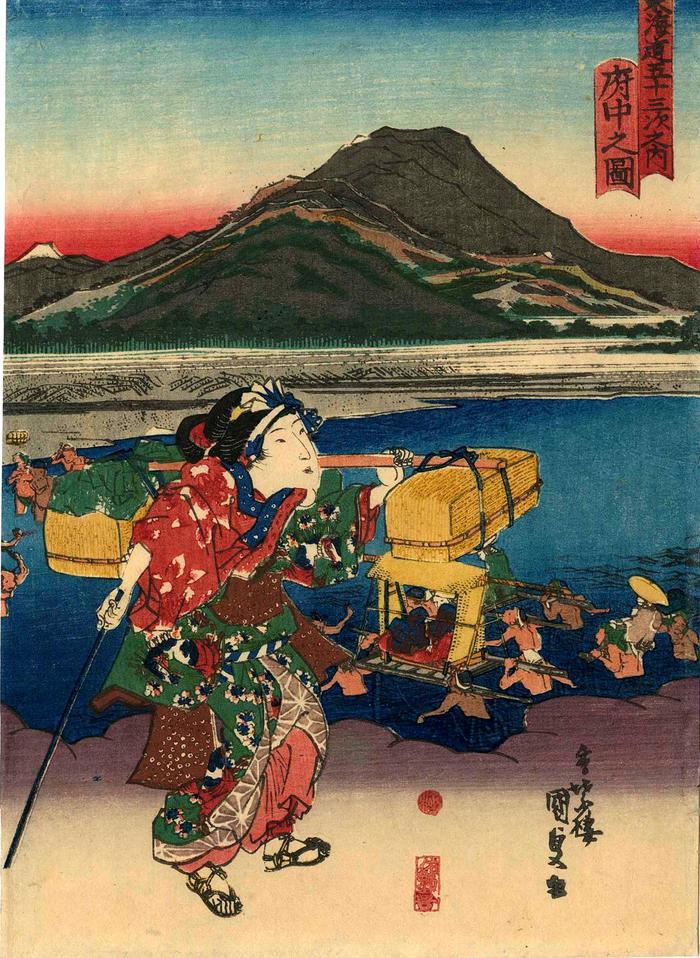Utagawa Kunisada (歌川国貞) / Toyokuni III (三代豊国) (artist 1786 – 01/12/1865)
View of Fuchū (Fuchū no zu: 府中之図) from the series Fifty-three Stations of the Tōkaidō Road (Tōkaidō gojūsan tsugi no uchi: 東海道五十三次之内)
Signed: Kōchōrō Kunisada (香蝶楼国貞)
Publisher: Sanoya Kihei
Censor's seal: kiwame
Museum of Fine Arts, Boston - published by Moriya Jihei
National Diet Library - published by both Moriya Jihei and Sanoya Kihei
Östasiatiska Museet, Stockholm
Museum für angewandte Kunst, Vienna
British Museum - Hiroshige's 'Fuchu Abe-gawa' version
Ishikawa Prefectural Museum of Art - they date their copy to 1836
Bryn Mawr
Honolulu Museum of Art - published by Moriya Jihei
Fujisawa Ukiyo-e Museum
Victoria and Albert Museum
Nelson-Atkins Museum of Art All of the prints in this series are chūban sized. The example of this print in the collection of the Museum of Fine Arts in Boston is 9 13/16 x 7 1/4 in. This one in the Lyon Collection is fractionally smaller because it has been trimmed slightly at the top and along the left hand side.
****
In Hokusai and Hiroshige: Great Japanese Prints from the James A. Michener Collection, Honolulu Academy of Arts on page 183 it says: "Fuchū, 6 miles from Ejiri, is located on the bank of the Abe River. It is now included in the large city of Shizuoka, Shizuoka prefecture. Fuchū was the most prestigious of Japan's castle towns, where Sumpu castle of Tokugawa Ieyasu, the first shogun of the Tokugawa bakufu, was located. Later this structure burned down."
****
This is number 20 in this series. The curatorial files at the Museum für angewandte Kunst in Vienna say: "The representation differs in very few details from Hiroshige's original. So, for example, the posture of the man on the far right who is carried on shoulders. In the foreground a woman in a rural style. She slipped out of one of the upper kimono sleeves and pulled the lower part of the skirt up with a ribbon. The kimono is decorated with toy horse and cherry blossom motifs. Obi in shibori technique 絞 り 染 め. She carries a pole over her shoulder with straw baskets attached to the ends. She is wearing simple straw sandals (waraji) and is holding a stick in her hand."
****
In Tokaido Landscapes: The Path from Hiroshige to Contemporary Artists, 2011, #20, p. 32, speaking of the original Hiroshige print it says in a text by Sasaki Moritoshi: "The Fuchū station was the seat of government for Suruga Province. The setting for the print is to the west of the station, where the crossing of the Abe River is depicted. In the foreground is a party of three women with a male attendant; the woman in the palanquin holds fast to her cushion to buffer the jostling of the passage. In the group at the left, the horse is losing its footing in the current and one of the men pulls at its harness. Behind them, a group of five men look on, walking more easily with their light loads."
****
In the background in the distance is the 200 meter high Mt. Shizuhata (賤機山). In Hiroshige: l'art du voyage, Paris, 2012, p. 70 it says: "La ville de Fuchū possédait un château et un vaste quartier des plaisirs."
****
Muneshige Narazaki in Masterworks of Ukiyo-e: Hiroshige, the 53 Stations of the Tōkaidō (p. 48) noted: "In ancient times, poets sang of the lonely beauty of the place (now part of Shizuoka) and of a bird, rather like a cuckoo, that inhabited the mountain. Ieyasu, first of the Tokugawa shoguns, has a castle here, where he spent more than a quarter of a century."
****
Illustrated in a small color reproduction in Kunisada's Tokaido: Riddles in Japanese Woodblock Prints by Andreas Marks, Hotei Publishing, 2013, page 67, T24-20.
Sanoya Kihei (佐野屋喜兵衛) (publisher)
landscape prints (fūkeiga 風景画) (genre)
beautiful woman picture (bijin-ga - 美人画) (genre)
